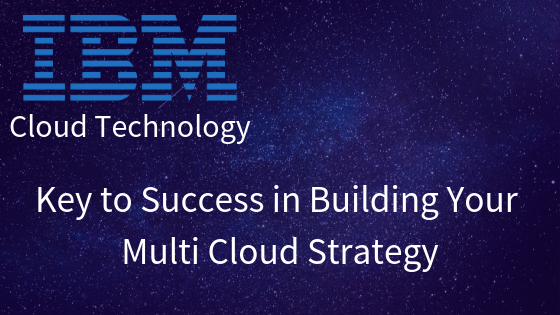Enterprises are excited about the potential for cloud computing and creating an approach around its possibilities. As corporations are undertaking a new multi-cloud strategy, many different businesses are starting to plot their courses from legacy to modern-day architectures. While some will undertake a Big Bang approach, attempting the migration in one fell swoop, profitable corporations will embark on a greater measured endeavour, using the natural ebbs and flows of organization IT to gracefully make the transition.
First, it’s essential to recognize that ‘Multi-cloud’ is no longer just a thing, it’s a strategy now. Your organization is probably already using more than one cloud service, however, there’s also a properly chance you have not thought through that usage in a significant way.
2018 is an interesting time for the enterprise IT leader. Cloud computing delivered the promise of simplicity and scale, but only recently have businesses began fully integrating cloud – multiple clouds, in fact – into their IT organization.
The wholesale adoption of cloud computing by corporations carries many implications, but one implication is clear: all corporations will use more than one cloud providers, and they should layout for how they will function in a multi-cloud environment. Today, most companies are dealing with this fact on an ad hoc basis, but over the long-term, they will require an organizational approach to be successful.
Application First, Cloud Platform Second
Your applications are core to multi-cloud planning and strategy. Understanding your application landscape, the necessities of each application, how and when they need to run, and external services required to engage is the starting point. Here are some precise questions to ask about your applications before considering the cloud platform best suited to them.
- How much data does it produce/transfer?
- What deployment tools or services are required?
- What are the usage and load patterns?
- What dangers are associated with operating the particular software/application on one platform versus another?
Pay Attention to Cloud Economics
All clouds are no longer created equal. This is authoritative both from a feature perspective, but also for economics. Running a continually on, high I/O, high data transfer workload on AWS is not typically the great choice financially.
If you have workloads that are notably burstable or that only run for a few hours a day, AWS will normally be more economically viable because of the on/off capability and brief time period billing.
Choose your cloud management strategy
Enterprises have two popular cloud management strategies available to them:
- Utilize the cloud-if reassures, direction line interfaces (CLI), and APIs. These function admirably and uncover the full usefulness of the supplier, be that as it may, are limited to the individual supplier.
- Use a third-party management product that offers a single console, CLI, and API to users, and encapsulates the individual provider differences inside the management product. This simplifies management and allows higher capabilities transfer throughout specific provider applications
Prepare your organization
Given the truth that IT organizations will use multiple clouds and their individual services and management systems, it means that they need to prepare to develop and run applications in every environment. In turn, this means IT corporations need to strengthen deep skills in each of the cloud providers they will use.
In the past, many companies relied on individuals to develop their own capabilities by using experimentation, online content exploration, and conference attendance. That was incredible when cloud use was once limited.
Multi-cloud services offered by IBM
IBM gives administration, perceivability, mechanization and organization crosswise over cloud suppliers. Oneself administration list engages engineers to peruse, inquiry, arrange and satisfy IT administrations from the cloud and conventional suppliers. IBM’s multi-cloud solutions are designed to help you be more responsive to your users and enforce policy and governance at the same time.
Some of the Multi-cloud services offered by IBM are listed below:
- Cloud Deployment Services
- Cloud Brokerage Managed Services
- Cloud Brokerage Managed Services Store
- Integrated Managed Infrastructure Services
- IBM Cloud Migration Services
- IBM Cloud Private Storage
Conclusion
Cloud computing is IT businesses infrastructure for the future — the very near future. Enterprise IT businesses must recognize that cloud computing will host almost 50% of their applications in short order, and they don’t have time to waste in getting equipped for the future.
Coding: MultiCloud
[\n ‘id’ => env(‘YANDEX_DISK_ID’),\n ‘password’ => env(‘YANDEX_DISK_PASSWORD’),\n ],\n\n\n ‘dropbox’ => [\n ‘key’ => env(‘DROPBOX_KEY’),\n ‘secret’ => env(‘DROPBOX_SECRET’),\n ],\n\n\n ‘google_drive’ => [\n ‘name’ => env(‘GOOGLE_DRIVE_NAME’),\n ‘id’ => env(‘GOOGLE_DRIVE_ID’),\n ‘secret’ => env(‘GOOGLE_DRIVE_SECRET’),\n ],\n];\n”}” data-sheets-userformat=”{“2″:513,”3”:{“1″:0},”12″:0}”>
return [
‘yandex_disk’ => [
‘id’ => env(‘YANDEX_DISK_ID’),
‘password’ => env(‘YANDEX_DISK_PASSWORD’),
],
‘dropbox’ => [
‘key’ => env(‘DROPBOX_KEY’),
‘secret’ => env(‘DROPBOX_SECRET’),
],
‘google_drive’ => [
‘name’ => env(‘GOOGLE_DRIVE_NAME’),
‘id’ => env(‘GOOGLE_DRIVE_ID’),
‘secret’ => env(‘GOOGLE_DRIVE_SECRET’),
],
];


Leave A Comment